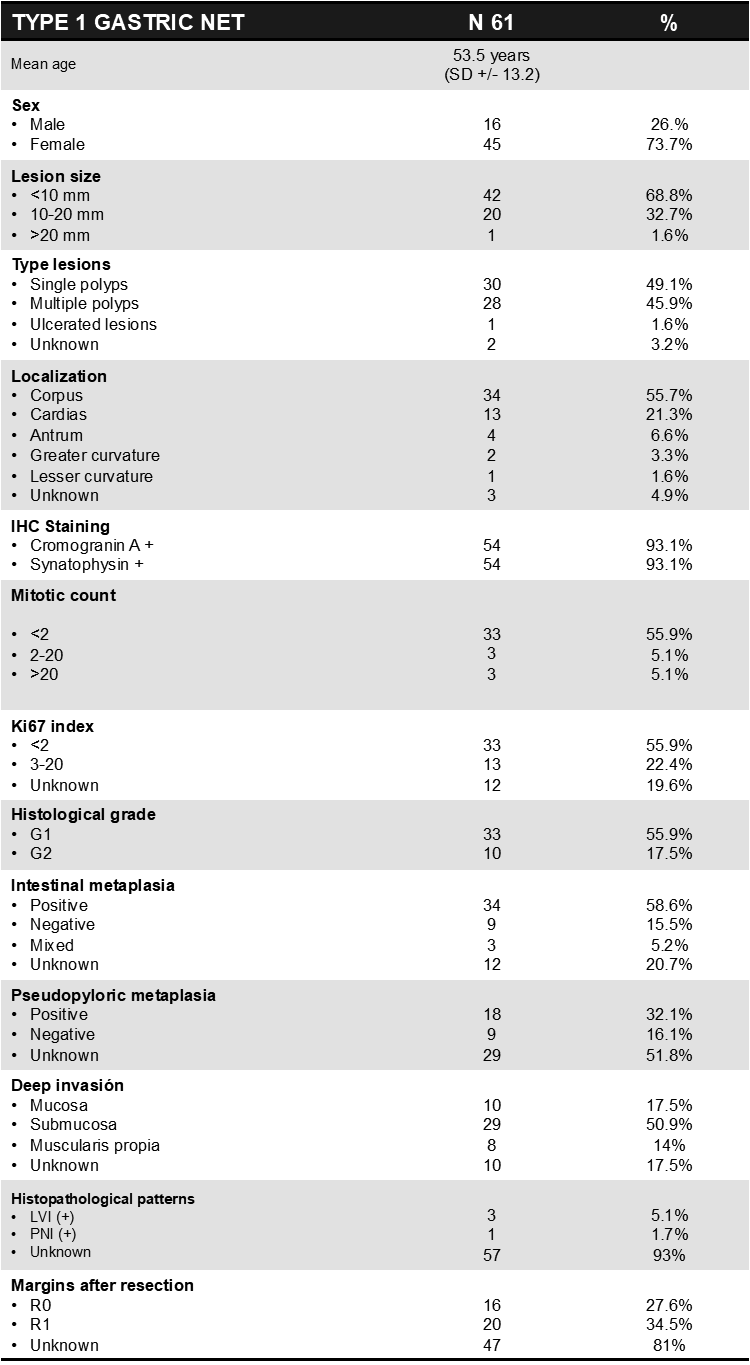NANETS2023 Clinical – Chemo/SSA/Biologics (17 abstracts)
Argentinian registry of gastric neuroendocrine tumors: A closer look at type 1
Ana Oviedo 1 , Romina Luca 2 , Claudia Bestani 3 , Andrés Rodriguez 2 , Federico Waisberg 2 , Carla Ypa 4 , Greta Catani 2 , Andrea Acosta 1 , Julian Maquieira 1 , Teresa Pombo 6 , Mirta Kujaruk 5 , Guillermo Méndez 1 & Juan O’Connor 2
1Oncology Unit, Gastroenterology Hospital “Dr. Carlos Bonorino Udaondo”, Buenos Aires, Argentina; 2Medical Oncology Department, Alexander Fleming Institute, Hospital, Buenos Aires, Argentina; 3Gastroenterology Unit, Gastroenterology Hospital “Dr. Carlos Bonorino Udaondo”, Buenos Aires, Argentina; 4Medical Oncology Department, Oncology Hospital “Maria Curie”, Buenos Aires, Argentina; 5Pathology Unit, Gastroenterology Hospital “Dr. Carlos Bonorino Udaondo”, Buenos Aires, Argentina; 6Pathology Department, Alexander Fleming Institute, Hospital, Buenos Aires, Argentina
Background: Gastric neuroendocrine tumors (gNETs) are relatively uncommon. Represent up to 23% of all digestive neuroendocrine neoplasms. The majority are incidentally diagnosed from histology of ‘simple’ gastric polyps identified at endoscopy. There are 3 groups of gNETs: types 1, 2 and 3 with different pathogeneses, biological and clinical behaviors. It is worth mentioning that recent reports suggest a fourth type of gNETs1. Type I represents 75–80% of all gNETs and are mostly related to chronic atrophic gastritis, which is reflected by the presence of multiple small lesions in about 65% of cases. They are usually of indolent behavior and characterized as non-functioning and well differentiated NETs. Nevertheless, rare cases of negligible risk of metastases (<5%)2 poorly differentiated tumors and prognosis have been described in the literature. We aimed to explored clinicopathological characteristics of type I gNETs and explored prognostic factors associated with progression free survival (PFS) in patients that were followed in two referenced centers in Argentina.
Methods: This study was part of a multicentric and retrospective register of patients with gNETs diagnosis from 2009 to 2023. Descriptive statistics was used to summarize main patient characteristics, including mean and standard deviation. PFS was calculated considering the interval between tumor interventions, which included endoscopic resections. Survival data was analyzed using the Kaplan-Meier method, and we evaluated the presence of prognostic factors using uni and multivariate Cox regression models.
Results: Of the 81 assessable patients with gNETs, 61(75.3%) were type 1. Mean age at diagnosis was 53.5 years (SD +/-13.2), 45(73.7%) were women. Most frequent localization was gastric corpus 34(55.7%). Cromogranin A and synaptophysin were positive in 54(93.1%) cases. Histological grade was G1 in 29 (50.9%) patients. Anti-parietal and anti-intrinsic factor autoantibodies were positive in 35 (57.4%) and 8 (13.1%) patients, respectively. Mucosal and distant relapse were observed in 15(24.5%) and 2(5.6%), patients respectively. Median follow-up was 85.2 months (95% CI 40-NR). Median PFS(PFSm) was 42.73 months CI95% (30-74m). No differences in PFS were observed in patients according to different subgroups including high serum gastrin (P=0.14), localization (P=0.67; corpus 35.9 (18.4-NR) vs fundus 64.86 (23.1-NR)), and endoscopic vs surgical treatment (P=0.97). Distant relapse had been found in 3.2% (n=2) of this cohort. Considering the median follow up of 86 months, a distant relapse free survival of 100% was estimated. Multivariate models did not show a specific prognostic factor associated with PFS.

Conclusion: Our study represents one of the largest gNETs cohorts reported in Latin America. No prognostic factors for PFS were identified in uni or multivariate models. Most patients received surgical or endoscopic treatment in at least one point of their treatment care plan, and only 2 events of distant recurrence were identified. The complexity of these tumors should be discussed in a multidisciplinary board of neuroendocrine tumors and further studies are required to facilitate the identification of the genetic and molecular information of the disease, thereby enabling the development of new effective diagnostic and therapeutic strategies advances in the treatment of gNETs.
Abstract ID 23810




